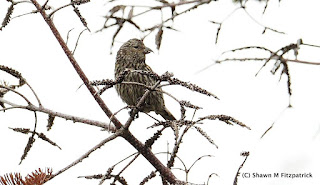I received a couple of photos from local birder Shawn Fitzpatrick today of a juvenile Crossbill. He never had exceptional looks at the bird but did manage to grab several photos. Quite often Crossbill identification is relatively straightforward. We have two species to consider, Red and White-winged. White winged Crossbill (owing to its name) has white bars on it's wings. In fact, it's often referred to as Two-barred Crossbill in Europe. As well, males of both species are shades of Red and females shades of yellow, they are different tones ,and as I said, identifying them generally isn't overly challenging.
However, in case I'm referring to, the bird was a juvenile, so entirely streaked brown and the photos were from essentially front on, so you really could not see if the bird had wing bars or not.So here is the bird in question.
 |
| Juvenile White-winged Crossbill (Photo Shawn Fitzpatrick) |
Let me explain how I went about identifying this bird. The first thing I noticed about this bird was it's bill. One of the differences in White-winged and Red Crossbill is bill size (there are many types of Red Crossbills with varying bill sizes, but typically, Newfoundland Red Crossbills have larger bills than White-wined, it is both thicker and longer). This birds bill struck me as somewhat thin, not appearing overly robust or strong and seemed to narrow a lot towards the tip.
 |
| Juvenile White-winged Crossbill (Photo Shawn Fitzpatrick) |
The next thing that struck me was the length of the tail. One thing I have always noticed is White-winged Crossbills are a relatively long tailed Finch. Look at the birds tail in the second photo, notice, it's length notice how quickly it tapers as it extends from the birds back, almost like you pinched it between your fingers. Not look at the actual tail feathers. Notice how far the tail feathers extend beyond the under tail coverts, this bird has a tail. When you see them at some distance, their tail length is almost reminiscent of Pine Grosbeak- though certainly not as long.At any rate it is significantly longer than Red Cross bill, which at times hardly seems to have much of a tail at all. When you see Red Crossbills in the tree tops, you often don't notice their tails that much, since they are quite short. Note this, when you are viewing Crossbills in the future.
 |
Juvenile Red Crossbill- Note the difference in bill size with the above bird. Note especially how the upper mandible tends to be thicker towards the tip.
One other feature that kind of struck me about the bird above was the pattern of streaking. The streaks seemed fine, on a relatively pale base, especially around the side of the face (ear coverts). I'm pretty sure this is variable and will change quickly as birds mature, but the bird in the first two photos, has a facial pattern kind of reminded me of Pine Siskin. Now look at the bird in the photo just above. Note how the face is a little more solidly coloured.
One other feature that I noted in the second photo above was the amount of fine streaking on the birds shoulders (scapulars). Note the juvenile Red Crossbills above, how plain brown the shoulders are. I'm not entirely sure how reliable these feature are, there are perhaps at best an accessory. It's something I'll continue to look for when I see these species.
I'd like to thank Shawn for send me the photos and inspiring this post.
|








No comments:
Post a Comment